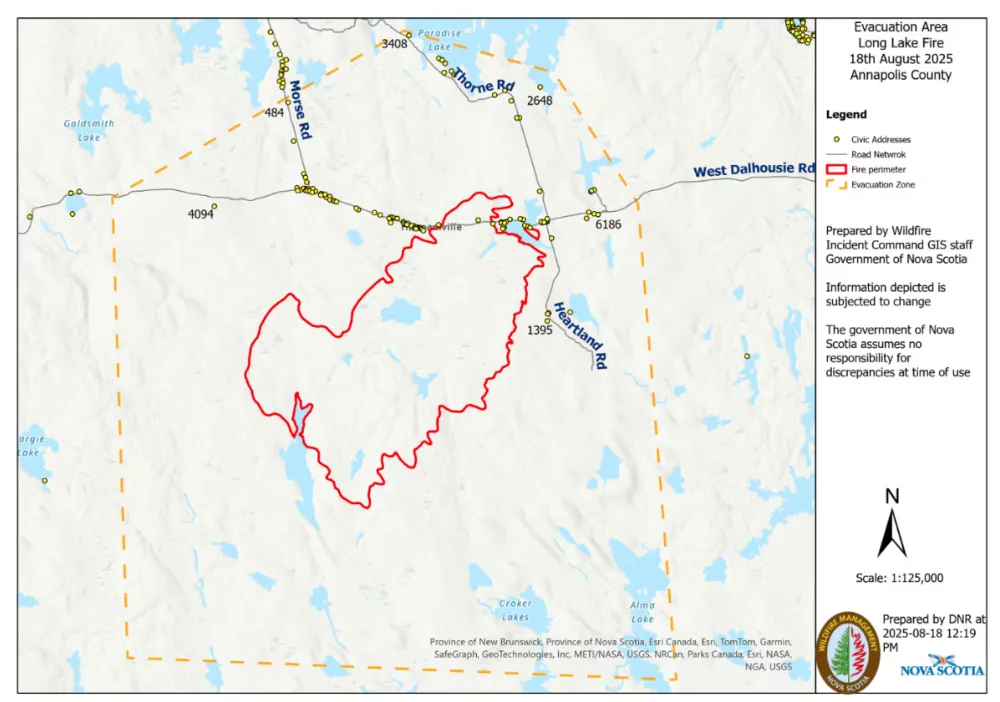
Wildfire burning in Annapolis County did not grow overnight: Natural Resources
Nova Scotia's Department of Natural Resources says an out-of-control wildfire burning in Annapolis County did not grow overnight and crews are making good progress.
A social media post from the department on Tuesday morning said the fire near the community of West Dalhousie is still estimated to be 3,210 hectares, roughly 32 square kilometres.
It said progress was made on Monday, as crews worked on making dozer guards, which use bulldozers to remove trees, shrubs and other fire fuels to help stop or slow a fire.
SEE ALSO: 2025 is Canada's second-worst wildfire season on record for area burned
There is still no reports of damage to homes, however some property — including campers and trailers — have been destroyed.
Officials have evacuated 107 homes in the West Dalhousie area, affecting roughly 215 people.

A map shows the perimeter of the Long Lake wildfire, including where homes have been evacuated, as of 12:19 p.m. Monday. (Province of Nova Scotia)
Dustin Enslow, the deputy warden of the Municipality of the County of Annapolis, said he is encouraged by Monday's progress.
"It was a bit of a relief considering the day before was one of the worst days we had since the beginning of the fire. So it was a bit of a good news story," Enslow told CBC Radio's Information Morning Cape Breton on Tuesday.
"The only downside is that we're not predicting rain for the next short period of time."
According to Environment Canada, the next chance of showers isn't until Monday.
Enslow said sprinklers that have been placed on nearby homes have been very effective. They create a constant stream of water that mimics rain, which helps prevent falling embers from sparking a fire, he said.
"It's really the first time it's been utilized at this capacity in Nova Scotia," said Enslow, adding that each home has at least two sprinklers.
"It's been a couple days since I've been out to the site but when we were out there it was nice to see all the houses look as if they're being rained on."

An aerial photo shows the West Dalhousie Community Centre, which is serving as the incident command post for the wildfire. Smoke from the Long Lake fire can be seen in the background. (Province of Nova Scotia)
There are 93 Department of Natural Resources firefighters on the ground on Tuesday, plus 59 local firefighters and 22 from Ontario.
RELATED: From flames to forecasts: How wildfire smoke affects your weather
There are also four planes from the Northwest Territories and one helicopter helping fight the fire.
Nova Scotia Premier Tim Houston said Monday that three more helicopters were on the way from Saskatchewan.
He said the province has no plans to purchase a fixed-wing water bomber, but that may change in the future.
"We're concerned about the fires. We're concerned about the frequency of them, so we want to make sure that our teams have the best possible assets to fight them," Houston said.
"It could be that as we go forward … that's a part of it, but it's an evaluation right now. We're fighting the fires with everything we have."
A news release from the Annapolis Regional Emergency Management Organization said the evacuation reception centre and shelter at the Annapolis Valley campus of NSCC in Middleton will now operate daily from 8 a.m. to 8 p.m. local time.
The centre provides evacuees with meals, access to facilities including showers and laundry and serves as a supply pickup location.
On Friday, a helicopter crashed into a lake while helping fight the wildfire.
A statement from the Transportation Safety Board of Canada on Saturday said the pilot of the Airbus AS 350 B3 had minor injuries.
"We are currently gathering data and information on the occurrence, while assessing the next steps," the statement said.
Nova Scotia's wildfire dashboard says there are five wildfires burning in the province. Long Lake, which started last Wednesday, is the only one listed as out of control.
Environment Canada's air quality health index forecasts a low risk for much of the province for Tuesday. It has issued special air quality statements for Annapolis and Queens counties.
The story was originally published for CBC News. With files from Information Morning Cape Breton
Thumbnail courtesy of Neil Green via CBC.